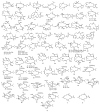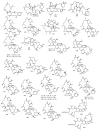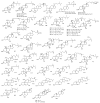Chemical Diversity in Species Belonging to Soft Coral Genus Sacrophyton and Its Impact on Biological Activity: A Review
- PMID: 31935862
- PMCID: PMC7024209
- DOI: 10.3390/md18010041
Chemical Diversity in Species Belonging to Soft Coral Genus Sacrophyton and Its Impact on Biological Activity: A Review
Abstract
One of the most widely distributed soft coral species, found especially in shallow waters of the Indo-Pacific region, Red Sea, Mediterranean Sea, and also the Arctic, is genus Sacrophyton. The total number of species belonging to it was estimated to be 40. Sarcophyton species are considered to be a reservoir of bioactive natural metabolites. Secondary metabolites isolated from members belonging to this genus show great chemical diversity. They are rich in terpenoids, in particular, cembranoids diterpenes, tetratepenoids, triterpenoids, and ceramide, in addition to steroids, sesquiterpenes, and fatty acids. They showed a broad range of potent biological activities, such as antitumor, neuroprotective, antimicrobial, antiviral, antidiabetic, antifouling, and anti-inflammatory activity. This review presents all isolated secondary metabolites from species of genera Sacrophyton, as well as their reported biological activities covering a period of about two decades (1998-2019). It deals with 481 metabolites, including 323 diterpenes, 39 biscembranoids, 11 sesquiterpenes, 53 polyoxygenated sterols, and 55 miscellaneous and their pharmacological activities.
Keywords: Sacrphyton; anti-inflammatory; antidiabetic; antimicrobial; antitumor; soft coral; terpenoids.
Conflict of interest statement
The authors declare no conflicts of interest.
Figures











Similar articles
-
The Soft Coral Sarcophyton trocheliophorum: A Warehouse of Terpenoids with Structural and Pharmacological Diversity.Mar Drugs. 2022 Dec 29;21(1):30. doi: 10.3390/md21010030. Mar Drugs. 2022. PMID: 36662203 Free PMC article. Review.
-
Terpenoids from Marine Soft Coral of the Genus Xenia in 1977 to 2019.Molecules. 2020 Nov 18;25(22):5386. doi: 10.3390/molecules25225386. Molecules. 2020. PMID: 33217924 Free PMC article. Review.
-
Recent Updates on Sinularia Soft Coral.Mini Rev Med Chem. 2022;22(8):1152-1196. doi: 10.2174/1389557521666210927152249. Mini Rev Med Chem. 2022. PMID: 34579632
-
Recent Updates on Corals from Nephtheidae.Chem Biodivers. 2019 Jun;16(6):e1800692. doi: 10.1002/cbdv.201800692. Epub 2019 May 20. Chem Biodivers. 2019. PMID: 30957385 Review.
-
Terpenes from the soft corals of the genus Sarcophyton: chemistry and biological activities.Chem Biodivers. 2013 Dec;10(12):2161-96. doi: 10.1002/cbdv.201200122. Chem Biodivers. 2013. PMID: 24327439 Review.
Cited by
-
Sarcoconvolutums F and G: Polyoxygenated Cembrane-Type Diterpenoids from Sarcophyton convolutum, a Red Sea Soft Coral.Molecules. 2022 Sep 8;27(18):5835. doi: 10.3390/molecules27185835. Molecules. 2022. PMID: 36144570 Free PMC article.
-
Uncommon Capnosane Diterpenes with Neuroprotective Potential from South China Sea Soft Coral Sarcophyton boettgeri.Mar Drugs. 2022 Sep 25;20(10):602. doi: 10.3390/md20100602. Mar Drugs. 2022. PMID: 36286428 Free PMC article.
-
Mililatensols A-C, New Records of Sarsolenane and Capnosane Diterpenes from Soft Coral Sarcophyton mililatensis.Mar Drugs. 2022 Sep 6;20(9):566. doi: 10.3390/md20090566. Mar Drugs. 2022. PMID: 36135755 Free PMC article.
-
The Soft Coral Sarcophyton trocheliophorum: A Warehouse of Terpenoids with Structural and Pharmacological Diversity.Mar Drugs. 2022 Dec 29;21(1):30. doi: 10.3390/md21010030. Mar Drugs. 2022. PMID: 36662203 Free PMC article. Review.
-
Structurally Diverse Diterpenes from the South China Sea Soft Coral Sarcophyton trocheliophorum.Mar Drugs. 2023 Jan 20;21(2):69. doi: 10.3390/md21020069. Mar Drugs. 2023. PMID: 36827110 Free PMC article.
References
-
- Rajendra S., Raghunathan C., Chandra K. New record of Sarcophyton cornispiculatum Verseveldt, 1971 (Octocorallia: Alcyonacea: Alcyoniidae) in India, from the Andaman Islands. Eur. Zool. J. 2017;84:167–171. doi: 10.1080/24750263.2017.1296036. - DOI
-
- Verseveldt J. A revision of the genus Sarcophyton Lesson (Octocorallia, Alcyonacea) Zool. Verhandel. 1982;192:1–91.
-
- Alderslade P. A redescription of Alcyonium agaricum Stimpson with a generic placement in Sarcophyton (Coelenterata: Octocorallia) Precious Corals Octocorals Res. 1993;1:20–29.
-
- Alderslade P., Shirwaiker P. New species of soft corals (Coelenterata: Octocorallia) from the Laccadive Archipelago. Beagle. 1991;8:189–233.
Publication types
MeSH terms
Substances
LinkOut - more resources
Full Text Sources
Research Materials

